
Carly Hanna
BSc (Human Nutrition and Psychology)
Jump to:
- What is N-Acetyl Cysteine (NAC)?
- N-Acetyl Cysteine deficiency
- Different types of NAC
- Health Benefits
- Health Claims
- Best Sources of NAC
- Daily requirements and intake
- How to take NAC
- Signs and symptoms of deficiency
- Risks and side effects
- Interactions - herbs and supplements
- Interactions - medication
- Summary
- Related Questions
In many countries, N-acetyl cysteine (NAC) is classified as a dietary supplement that enhances the production of glutathione and assists with reducing oxidative stress. In the US, however, NAC is classified as a drug/medication and cannot be sold over the counter.
This obviously limits a large number of people to benefit from the positive effects that NAC exhibits, such as
- Boosting our immunity system
- Protecting our cardiovascular and renal health
- Protecting our brain and assisting with mental health disorders
- Boosting our performance and strength levels
- Keeping our antioxidant levels high
If you would like to know more about NAC and if you should include it (as a supplement) in your daily routine, or increase foods that are high in cysteine, we encourage you to read the article, and make a few notes along the way.
What is N-Acetyl Cysteine (NAC)?
N-Acetyl Cysteine (otherwise known as NAC) is a supplement form and precursor of the amino acid cysteine.[1]
Cysteine is one of the twenty-two amino acids, which are the building blocks of proteins in the body. Along with the other amino acids glycine and glutamate, cysteine is the most evidence-based amino acid precursor to making glutathione, a very important antioxidant.[2]
Antioxidants can help reduce oxidative stress
By reducing free radicals, this may also help lower the risk of different types of cancer.[3]

First use of NAC in clinical practice
NAC was first used for clinical benefits in the 1960’s for patients with cystic fibrosis. In the 1980’s it again started to gain research interest in antioxidant properties for conditions such as cancer.[5] From then on, NAC has been researched to help with
N-Acetyl Cysteine deficiency
Cysteine is a non-essential amino acid. This means that the body can produce cysteine on its own as well as obtain it from the diet. However an NAC deficiency can still occur.
Important note – essential amino acids can only be obtained from the food we eat.
NAC is vital for the modulation of the glutamate system, which is the reward/reinforcement pathway of the body.[6] Both glutamate and glutathione systems are important metabolic pathways that affect physical and mental health.[6]
NAC deficiency can affect different parts of the body, including
- immunity
- brain (including mental health)
- respiratory system
- heart
- digestive and renal system
- fertility
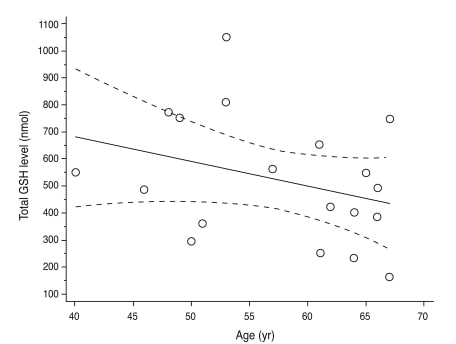
Source: Moon, J. Circulating Total Glutathione in Normal Tension Glaucoma Patients: Comparison with Normal Control Subjects. (2012)
These symptoms occur mainly through the mechanism of having depleted glutathione levels and having an increase in oxidative stress. This mechanism is explained further in detail in the following sections.
Who is most at risk of N-Acetyl Cysteine deficiency?
NAC deficiency often accompanies low glutathione levels.
Glutathione can be low during certain periods of life, with certain lifestyle factors, and also due to genetic and medical reasons.
The following groups are more at risk of an NAC deficiency and may need more cysteine than the general population.
High blood sugar and NAC
Both type I and type II diabetics are at risk of having low glutathione levels, which results in higher levels of oxidative stress. This is why those who have dysregulated blood sugar, may need more cysteine in order to produce healthy levels of glutathione.[2]
RELATED — Type 1 Diabetes: Autoimmune disease that is on the rise
High blood pressure and NAC
Similar to individuals with high blood sugar, people who have high blood pressure (eg. hypertension) need more cysteine in order to produce healthy levels of glutathione. This is to balance the high levels of oxidative stress that come with having hypertension.[2]
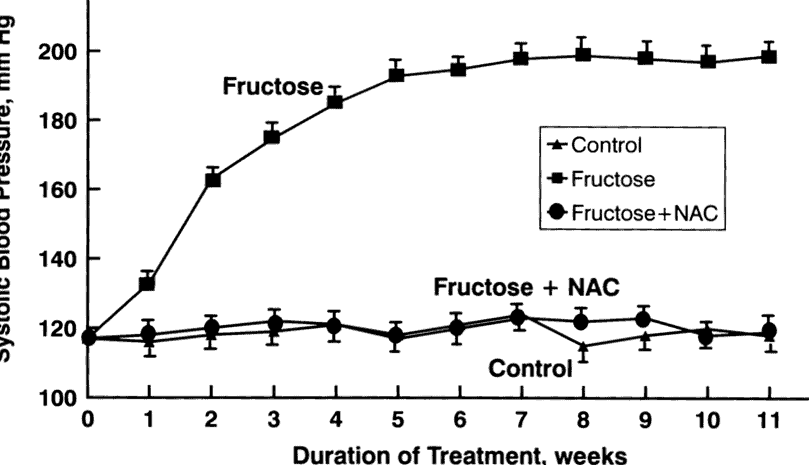
Source: Longerich, L. Role of aldehydes in fructose induced hypertension. Molecular and Cellular Biochemistry. (1998)
Elderlies and NAC levels
As we age, our body’s ability to synthesise and absorb nutrients from food decreases. This is why older people are more likely to be at risk of developing a NAC deficiency.[2]
Immunity and NAC
When our body doesn’t have enough glutathione, our ability to fight infections decreases.
Likewise, if we have an infection, our body is likely to need more cysteine to produce enough glutathione.[2]
Poor nutrition and NAC absorption
Not consuming enough food can lead to multiple nutrient deficiencies, including NAC. Insufficient nutrition can come from lifestyle behaviours, such as disordered eating, or medical causes, such as infection or gut disorders. This is because the body’s ability to absorb nutrients is disrupted.[2]
RELATED — Understanding Eating Disorders: History, Types and Statistics
High performance exercise and NAC requirements
Individuals who enjoy a lot of exercise, whether that be occupationally, recreationally, or for elite sport are likely to have a higher energy and/or protein requirement. The increase in need for certain nutrients, such as NAC, is for the building and repairing of muscles.[2]
Alcohol and NAC absorption
Alcohol can limit the absorption of nutrients in the body, so if we drink a lot of alcohol, this can put us at risk of NAC deficiency.[2]
Different types of N-Acetyl Cysteine
There are two types of NAC
- Cysteine which is naturally found in foods such as meat, eggs, legumes and nuts/seeds
- N-Acetyl L-Cysteine which is in a supplement form (powder, gel, capsule or spray)
It’s best to get NAC from our diet first
Our diet can provide bioavailable nutrients that are absorbed faster into the body, and have added benefits such as accompanying macronutrients (protein, fat and carbohydrate) and micronutrients (vitamins and minerals).
Important note – NAC in supplement form has low bioavailability. However, if you are at risk of an NAC deficiency, a supplement can be a good back-up.
Health benefits of N-Acetyl Cysteine
There have been several studies looking at NAC’s efficacy on improving mental and physical health. Health benefits of taking this supplement are explained below.
NAC increases glutathione production
NAC’s main mechanism for health benefits is through increasing production of glutathione. Glutathione deficiency can contribute to:
- Alzheimer’s disease (brain cell degeneration causing memory loss)
- Parkinson’s disease (cell damage that leads to the loss of dopamine, characterised by tremors)
- Huntington’s disease (nerve cell damage that results in motor and memory loss)
Evidence has shown that NAC supplementation can help reduce the risk of these neurodegenerative diseases because NAC and glutathione are important for fighting cellular damage.[7]
NAC supports performance
In a study with cycling athletes, NAC infusions increased time to fatigue by 26% than controls.[8] This improved muscle performance is likely due to glutathione availability and enhanced muscle cysteine levels.

Source: Powers, S. Exercise-induced oxidative stress in humans: Cause and consequences. (2010)
NAC as an antioxidant against cancer
NAC is a precursor to glutathione, which is an antioxidant that has chemoprotective properties against lung cancer by helping DNA repair.[9]
The recommended safe dose of NAC for chemoprotective properties is 600mg daily.[10] There is also evidence to suggest that NAC can help reduce the risk of colon cancer.[3]
NAC helps manage HIV symptoms
A robust study showed that oral NAC can replenish glutathione levels in patients with HIV infection. Although HIV is not curable, supplementation can help manage symptoms and quality of life.[11]
NAC increases magnesium levels
Regardless of whether we have blood pressure issues or not, NAC supplementation has shown to increase magnesium levels.[2]

Source: Resnick, L. Effects of Glutathione on Red Blood Cell Intracellular Magnesium. (1999)
NAC reduces oxidative stress
When there is an imbalance between free radicals and antioxidants in the body, this can lead to oxidative stress and subsequent physical and mental health problems.
Supplementing with NAC for two weeks has shown to reduce levels of oxidative stress.[2]
NAC supports kidney and liver function
NAC improves mental health
Oxidative stress has been associated with a variety of psychiatric disorders including:
- Anxiety – 1-2g NAC daily can help reduce subjective anxiety through glutathione activity[13]
- Depression – 1g NAC daily can help depressive symptoms[13]
- Bipolar disorder – 1g NAC twice daily with usual medication, lowered depressive symptoms but not mania[14]
- Schizophrenia – 1g NAC twice daily helped with restlessness[6,15]
- Substance use disorder – preliminary evidence suggest that NAC can potentially help with addiction behaviour[1,12]
- OCD (obsessive-compulsive disorders) – NAC influences the amino acid glutamine. This system is responsible for reward and reinforcement that is often prevalent in OCD behaviour[6]
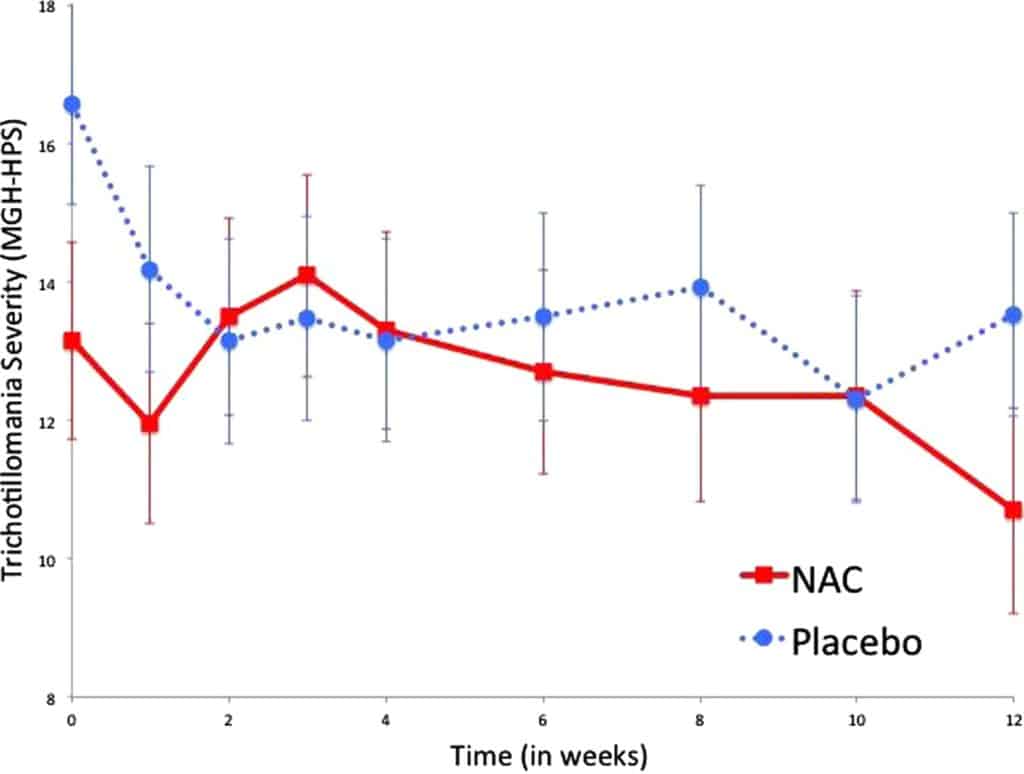
Source: Grant., J. N-Acetylcysteine in the Treatment of Pediatric Trichotillomania: A Randomized, Double-Blind, Placebo-Controlled Add-On Trial. Child and Adolescent Psychiatry. (2013)
NAC supports immunity
NAC increases the levels of natural killer cells
NAC reduces the risk of heart disease
Maintaining healthy cholesterol levels can help reduce our risk of cardiovascular disease. NAC can help reduce oxidative stress, which affects the lipids as LDL (low density lipoprotein) is associated with cholesterol.[2]
There is also evidence that NAC improves nitric oxide production (and blood flow) which can reduce our risk of a heart attack through its antioxidant properties.[1,12]
NAC stabilises blood sugar levels
Research has shown that NAC may help stabilise blood sugar, reduce the risk of Type II diabetes and improve insulin resistance for those that have PCOS (polycystic ovarian syndrome).[12]
RELATED — Diabetes: Early Signs, Causes, Types and Treatment
NAC helps maintain healthy blood pressure
NAC has shown to reduce blood pressure by 5 mmHg in hypertensive patients.[9] This is due to decreasing oxidative damage to tissues in the heart.
NAC improves fertility
Antioxidants are important for both male and female reproductive systems. 600mg/day of NAC has shown to improve semen integrity and pregnancy rate by 22%.[1,12]
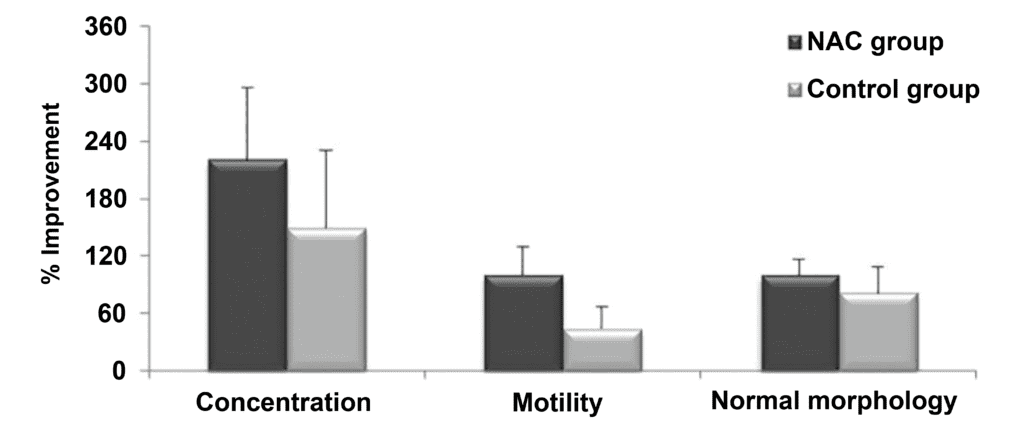
Source: Azadi, L., A Preliminary Study: N-acetyl-L-cysteine Improves Semen Quality following Varicocelectomy. (2016)
NAC boosts brain health
NAC improves respiratory health
Health claims that still need more evidence and research
NAC, chest pain and angina
When used in conjunction with other medication, such as nitroglycerin, NAC has shown to help with chest pain and angina symptoms. However, more research is needed to investigate the correlation.[17]
NAC and autism
Oral NAC supplements have shown to improve irritability in young people with autism, although no evidence supports improvement of other autistic symptoms.[17]
NAC and kidney damage
While there is plenty of evidence that supports NAC and kidney health, for individuals with kidney damage more research is needed to explore how NAC can help, which includes help with renal failure.[17]
NAC and high cholesterol
More research is needed to investigate the potential of NAC reducing levels of lipoprotein (fat in the blood). This is a low-density lipoprotein that can increase the risk of cholesterol build up in the heart arteries.[17]
NAC and cancer drug toxicity
NAC seems to prevent side effects of the cancer drug ifosfamide, but there are other drugs, such as mesna, that seem to have a better effect than NAC.[17]
Help with lung disease, flu and COVID-19 symptoms
NAC is believed to reduce flu symptoms, however, we need more evidence to support this claim.This includes reducing shortness of breath and inflammation of the airways [lungs].[17]
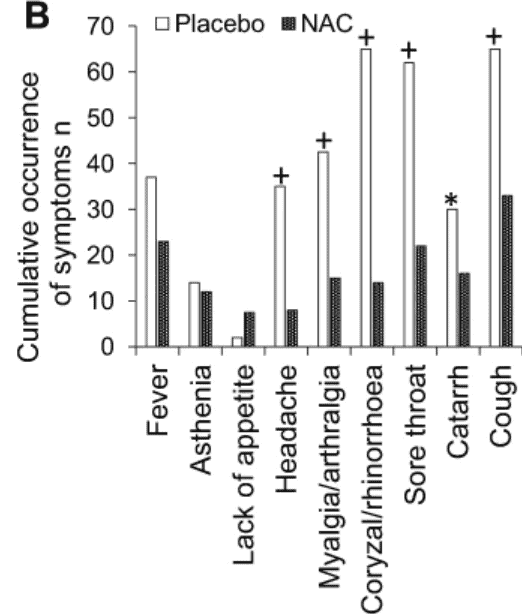
Source: Puyo, CA., N-Acetylcysteine to Combat COVID-19: An Evidence Review. Dovepress. (2020)
Taking oral NAC doses for six months have shown to help reduce flare ups by 40% of those with moderate-severe COPD (chronic obstructive pulmonary disease).[17]
There have also been case studies that have shown that NAC supplementation can help the treatment and management of COVID-19 symptoms.[18]
Best sources of N-Acetyl Cysteine
Nutrients from food are generally more bioavailable than those in a supplement form.
As the body naturally produces cysteine, there is no specific recommended daily intake (RDI). However, based on other research, we know that the body needs a certain amount of protein a day.
Food Source | Concentration (mg/100g) | Daily Value (DV) RDI% |
Cashews | 393 mg | 137% |
Sunflower Seeds | 383 mg | 133% |
Pork | 350 mg | 122% |
Beef | 345 mg | 120% |
Chicken | 336 mg | 117% |
Tuna | 321 mg | 112% |
Eggs | 292 mg | 102% |
Swiss Cheese | 290 mg | 101% |
Turkey | 265 mg | 92% |
Lamb | 252 mg | 88% |
Almonds | 215 mg | 75% |
Lentils | 118 mg | 41% |
Oats | 97 mg | 34% |
Black Beans | 96 mg | 33% |
Kidney Beans | 81 mg | 28% |
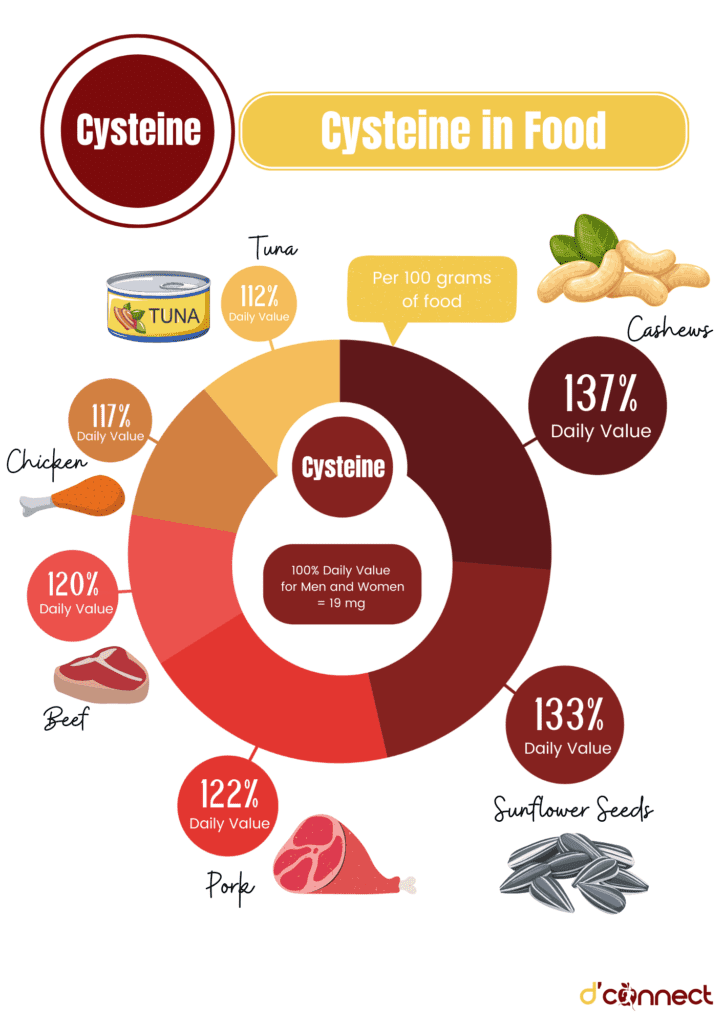
The calculations in the table below are based on a 70kg person, with an RDI of 287mg cysteine a day (about 4.1mg/kg day).[19]
Daily requirements and recommended intake
As mentioned previously, NAC is a non-essential amino acid so there is no set recommended daily intake (RDI).
However, protein requirements depend on the weight of the person (mg/kg) and also on our activity levels.
NAC in supplement form is not highly bioavailable
This means that the amount consumed isn’t necessarily the amount that is absorbed by the body.
This is why the requirements in the table below are higher than the RDI in the previous table.[20]
Age (years) | Male (mg NAC/kg) | Female (mg NAC/kg) |
Birth to 6 months | 59 | 59 |
7-11 months | 43 | 43 |
1-3 years | 28 | 28 |
4-8 years | 22 | 22 |
9-13 years | 22 | 21 |
14-18 years | 21 | 19 |
19+ years | 19 | 19 |
Important note – for women who are pregnant and/or are lactating, the amount of NAC per kilogram of body weight should be between 25-26 mg.
How to take N-Acetyl Cysteine
NAC can be administered intravenously or orally in a spray, liquid, or powder form. NAC has low bioavailability and is usually consumed orally with a dosage of around 600-1200mg daily.[17]
As an amino acid, NAC is water soluble, so taking with a glass of water instead of food can help absorption.
In order to process NAC more efficiently, it is recommended that NAC supplements are to be taken together with
- Vitamin B6 (Pyridoxine)
- Vitamin B9 (Folate)
- Vitamin B12 (Cobalamin)[2]
It is also recommended that NAC supplements should be taken with zinc to maximise the absorption rate.[21]
Common signs and symptoms of N-Acetyl Cysteine deficiency
Symptoms of NAC deficiency and low glutathione levels can be classified as mild, moderate and severe.
Mild to moderate deficiency symptoms of NAC
Mild NAC deficiency can result in the destruction of red blood cells (hemolytic anaemia).[22]
People can also experience increased acidity in the body (metabolic acidosis) which can manifest as symptoms including
- Nausea
- Fatigue
- Decreased appetite
- Confusion
- Heart arrhythmias
- Headache
- Hyperventilation (long and deep breaths).[22]
Severe deficiency symptoms of NAC
Severe deficiency can result in neurological symptoms, such as
- Seizures
- Psychomotor retardation (slowing down of movement and speech)
- Intellectual disability and/or mental health condition
- Loss of coordination (ataxia)
- Bacterial infections (due to compromised immune system).[22]
It is always recommend to check with a medical practitioner instead self-diagnosing.
N-Acetyl Cysteine risks and side effects
Excessive NAC slows blood clotting
Too much NAC can interfere with the body’s ability to produce blood clots. Therefore, NAC supplements can increase the risk of bleeding and bruising and also lead to bleeding disorders.[17]
NAC may reverse hyperglycemia
Individuals with diabetes usually have poor regulation of blood sugar levels. Although NAC may help with hyperglycemia (high blood sugar) it can also cause hypoglycemia (low blood sugar).[12]
Risk of NAC for people with asthma
Although unlikely, NAC could potentially increase the risk of bronchospasm, so always check with your physician before taking any supplements.[17]
NAC may cause kidney stones
Although it is rare, NAC supplements can cause kidney stones to form. This is due to the insoluble parts of NAC clotting together to form mineral build ups – which is otherwise known as kidney stones.[12]
Side effects of taking N-Acetyl Cysteine by oral supplements or nasal sprays
Oral supplements take longer to be absorbed in the body because NAC has to go through the digestive system. When taken by mouth, NAC supplements can cause
- Dry mouth
- Nausea
- Vomiting and diarrhoea[17]
Nasal sprays are absorbed faster in the body as NAC goes straight into the respiratory system. NAC supplements, however, in the form of sprays can cause
- Swelling in the mouth
- Runny nose
- Drowsiness
- Clamminess
- Chest tightness[17]
It advisable to check with your medical practitioner which for of NAC might be best suited for you.
Possible interactions with herbs and supplements
Possible interactions with medications
Summary
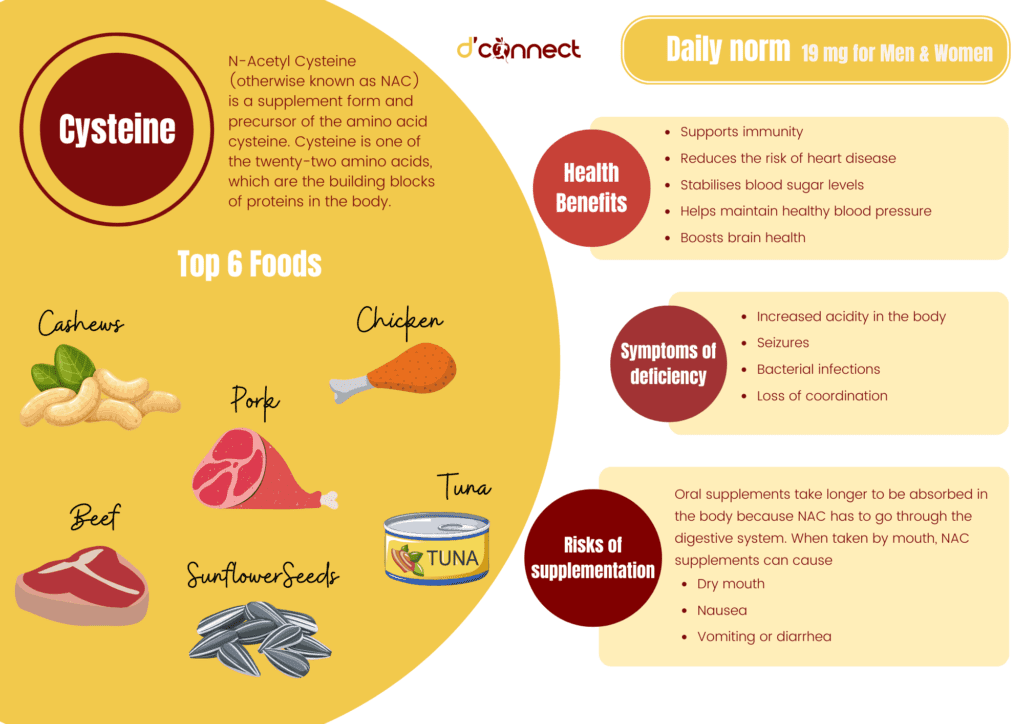
Key Takeaway – In this summary illustration we have outlined the most important information that you should know about n-acetyl cysteine (NAC).
Related Questions
1. What is the difference between NAC and cysteine?
N-Acetyl cysteine is a precursor/form of cysteine. Cysteine is a non-essential amino acid (building block of protein in the body).
2. What is the difference between essential and non-essential amino acids?
A non-essential amino acid can be produced by the body and also be obtained from food, whereas an essential amino acid can only be obtained from the diet/supplements, and is not produced in the body.
RELATED — What are Amino Acids and what is their role in keeping us healthy?
3. Why is NAC so important?
NAC is an important precursor to the antioxidant glutathione, which is involved in several important metabolic pathways in the body.
4. Do you need to take NAC supplements?
Unless you are at risk of a nutrient deficiency, you should always aim to get your nutrients from food first.
Consider a supplement if you are of old age, have poor nutrition, do excessive exercise, have high blood sugar or high blood pressure.
Have you tried taking NAC as a supplement? If so, have you seen any benefits? Please let us know in the comment section below.
Carly is currently an Intern Psychologist in the Whitiora Diabetes Service at Te Whatu Ora Counties Manukau. She has completed a Bachelor of Science, majoring in Human Nutrition and Psychology and is currently attaining her Masters in Health Psychology and Postgraduate Diploma in Health Psychology…
If you would like to learn more about Carly, see Expert: Carly Hanna.
References
(1) Goodson A. Top 9 Benefits of NAC (N-acetylcysteine). Healthline [Online]. 2022 Feb 11. Accessed 14/07/22. Retrieved from: https://www.healthline.com/nutrition/nac-benefits
(2) Smith A. 10 Research-Based Benefits of Glutathione and NAC (N-acetylcysteine). 2020 Aug 26. Nordic [Online]. Accessed 14/07/22. Retrieved from: https://www.nordic.com/healthy-science/benefits-of-glutathione-and-nac
(3) Atkuri KR, Mantovani JJ, Herzenberg LA, Herzenberg LA. N-Acetylcysteine—a safe antidote for cysteine/glutathione deficiency. Current opinion in [pharmacology. 2007 Aug 1;7(4):355-9. Retrieved from: https://www.ncbi.nlm.nih.gov/pmc/articles/PMC4540061/
(4) Church F, The Yack on NAC and Parkinson’s. Accessed 14/07/22. Retrieved from: https://journeywithparkinsons.com/2017/05/25/the-yack-on-nac-n-acetyl-cysteine-and-parkinsons/
(5) Rushworth GF, Megson IL. Existing and potential therapeutic uses for N-acetylcysteine: the need for conversion to intracellular glutathione for antioxidant benefits. Pharmacology & therapeutics. 2014 Feb 1;141(2):150-9. Retrieved from: https://doi.org/10.1016/j.pharmthera.2013.09.006
(6) Sansone RA, Sansone LA. Getting a Knack for NAC: N-Acetyl-Cysteine. Innovations in Clinical Neuroscience. 2011 Jan;8(1):10-14. PMID: 21311702; PMCID: PMC3036554. Retrieved from: https://europepmc.org/article/PMC/3036554
(7) Johnson WM, Wilson-Delfosse AL, Mieyal JJ. Dysregulation of glutathione homeostasis in neurodegenerative diseases. Nutrients. 2012 Oct 9;4(10):1399-440. Retrieved from: https://doi.org/10.3390/nu4101399
(8) Medved I, Brown MJ, Bjorksten AR, Murphy KT, Petersen AC, Sostaric S, Gong X, McKenna MJ. N-acetylcysteine enhances muscle cysteine and glutathione availability and attenuates fatigue during prolonged exercise in endurance-trained individuals. Journal of Applied Physiology. 2004 Oct 1. Retrieved from: https://doi.org/10.1152/japplphysiol.00371.2004
(9) Martina V, Masha A, Gigliardi VR, Brocato L, Manzato E, Berchio A, Massarenti P, Settanni F, Della Casa L, Bergamini S, Iannone A. Long-term N-acetylcysteine and L-arginine administration reduces endothelial activation and systolic blood pressure in hypertensive patients with type 2 diabetes. Diabetes care. 2008 May 1;31(5):940-4. Retrieved from: https://doi.org/10.2337/dc07-2251
(10) van Zandwijk, N., 1995. N‐acetylcysteine (NAC) and glutathione (GSH): antioxidant and chemopreventive properties, with special reference to lung cancer. Journal of Cellular Biochemistry, 59(S22), pp.24-32. Retrieved from: https://doi.org/10.1002/jcb.240590805
(11) De Rosa SC, Zaretsky MD, Dubs JG, Roederer M, Anderson M, Green A, Mitra D, Watanabe N, Nakamura H, Tjioe I, Deresinski SC. N‐acetylcysteine replenishes glutathione in HIV infection. European journal of clinical investigation. 2000 Oct 19;30(10):915-29. Retrieved from: https://doi.org/10.1046/j.1365-2362.2000.00736.x
(12) Brennan D. Health Benefits of NAC. WebMD [Online]. 2020 Nov 5. Accessed 14/07/22. Retrieved from: https://www.webmd.com/diet/health-benefits-nac#1
(13) Slattery J, Kumar N, Delhey L, Berk M, Dean O, Spielholz C, Frye R. Clinical trials of N-acetylcysteine in psychiatry and neurology: a systematic review. Neuroscience & Biobehavioral Reviews. 2015 Aug 1;55:294-321. Retrieved from: https://pubmed.ncbi.nlm.nih.gov/25957927/
(14) Berk M, Copolov DL, Dean O, Lu K, Jeavons S, Schapkaitz I, Anderson-Hunt M, Bush AI. N-acetyl cysteine for depressive symptoms in bipolar disorder—a double-blind randomized placebo-controlled trial. Biological psychiatry. 2008 Sep 15;64(6):468-75. Retrieved from: https://doi.org/10.1016/j.biopsych.2008.04.022
(15) Berk M, Copolov D, Dean O, Lu K, Jeavons S, Schapkaitz I, Anderson-Hunt M, Judd F, Katz F, Katz P, Ording-Jespersen S. N-acetyl cysteine as a glutathione precursor for schizophrenia—a double-blind, randomized, placebo-controlled trial. Biological psychiatry. 2008 Sep 1;64(5):361-8. Retrieved from: https://doi.org/10.1016/j.biopsych.2008.03.004
(16) Richie JP, Nichenametla S, Neidig W, Calcagnotto A, Haley JS, Schell TD, Muscat JE. Randomized controlled trial of oral glutathione supplementation on body stores of glutathione. European journal of nutrition. 2015 Mar;54(2):251-63. https://link.springer.com/article/10.1007/s00394-014-0706-z#citeas
(17) WebMD. N-acetylcysteine (NAC) – Uses, Side Effects and more. [Online]. Accessed 14/07/22. Retrieved from: https://www.webmd.com/vitamins/ai/ingredientmono-1018/n-acetyl-cysteine-nac
(18) Shi Z, Puyo CA. N-acetylcysteine to combat COVID-19: an evidence review. Therapeutics and Clinical Risk Management. 2020;16:1047. Retrieved from https://www.ncbi.nlm.nih.gov/pmc/articles/PMC7649937/
(19) Whitbread D. Top 10 Foods Highest in Cysteine. My Food Data [Online]. 2022 Apr 24. Retrieved from: https://www.myfooddata.com/articles/high-cystine-foods.php#cystine-rich-foods
(20) McAuley D. RDA and EAR recommendations for essential amino acids [Online]. 2018 Apr 21. Accessed 27/07/22. Retrieved from: https://globalrph.com/rda-and-ear-recommendations-for-essential-amino-acids/
(21) Koozehchian, M. N-Acetylcysteine, the obscure antioxidant. Huffins Institute. 2013, Feb 19. Accessed 19 July 2022. [Online]. Retrieved from: https://www.huffinesinstitute.org/Resources/Articles/ArticleID/410/N-Acetylcysteine-the-Obscure-Antioxidant
(22) MedlinePlus. Glutathione synthetase deficiency (2015 Mar 1) Accessed 21/7/22. [Online]. Retrieved from: https://medlineplus.gov/genetics/condition/glutathione-synthetase-deficiency/#:~:text=These%20problems%20may%20include%20seizures,also%20develop%20recurrent%20bacterial%20infections

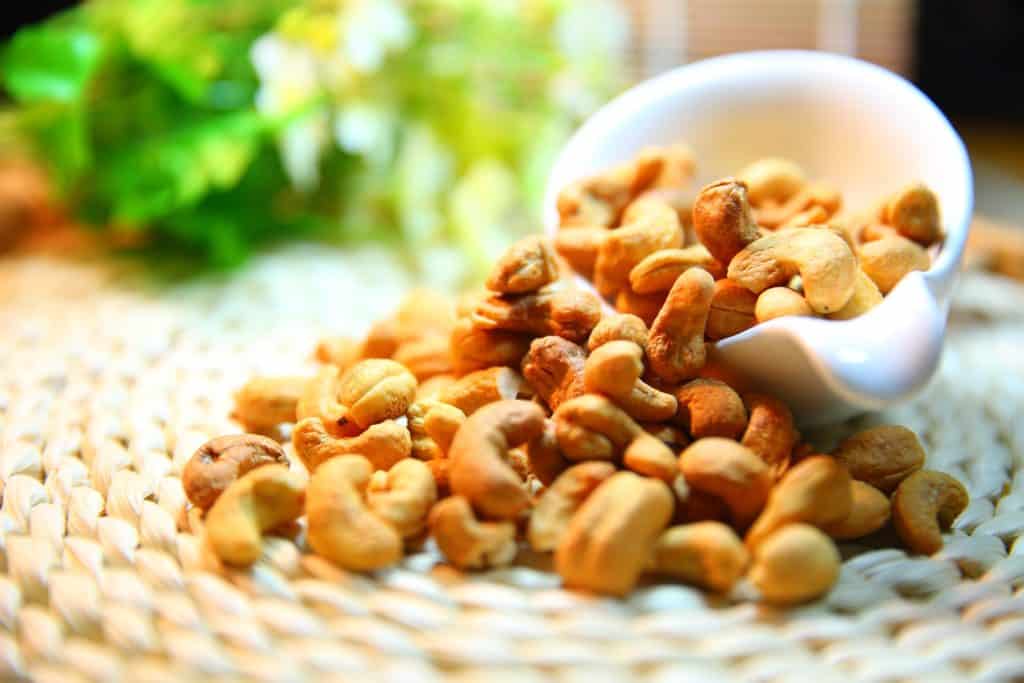


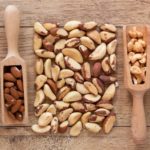


RELATED — Magnesium (for a great night of sleep)